
13-10
STORIES TOLD WITH PICTURES
Pictures let people ‘see’ what is happening in the story.
• Pictures let people ‘see’ what is happening in the story.
• A series of pictures can serve as a guide for the story teller.
• Pictures can be used to help a group tell a story from their own experience.
• Health workers can use flash cards or flip charts in discussing health problems
with groups of villagers, letting the group try to explain what is happening in the
pictures. This way students discover the health message themselves and
tell it to the teacher (rather than the teacher telling them).
This set of flash cards is based on pictures from page 132 of Where There is No Doctor.
In Chapter 11 we discussed the use of pictures on flash cards and flip charts.
But pictures can also be used to tell stories in comic strips, photonovels, color
slides (transparencies), filmstrips, or moving pictures (movies).
Comics and photonovels
In many countries, especially in Latin America, people read comic books more
than any other written materials. As a result, many comic books and photonovels*
have been produced on a variety of health topics. A few of them are excellent, but
many are a boring mixture of preaching and brainwashing, masked by a silly story.
Instead of using prepared materials, health workers can make their own comic
strips on health themes, or organize school children to make them. They can make
up stories and draw pictures to go with them, or copy pictures from other comic
books. If someone has a camera, the group may even be able to make photonovels
using local people as ‘stars’.
*Photonovels or fotonovelas are comic books that use photographs instead of drawings.